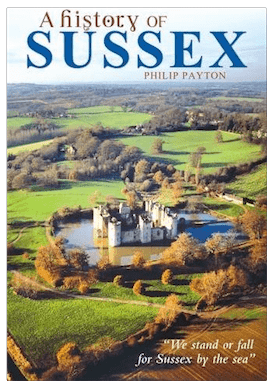Book Review: A History of Sussex
Posted: 2017-10-17
In 1912 an amateur archaeologist named Charles Dawson astounded the scientific world when he discovered the earliest human remains ever found in a gravel pit near the Sussex village of Piltdown, north of Lewes. Dawson built a worldwide reputation for his discovery, but that reputation was left in tatters when it emerged some four decades later that the skeletal remains were part of an elaborate hoax, with the skull constructed from a mix of human and ape bones carefully painted to give them an appearance of great age.
The story of Piltdown Man is one of the opening salvos of a fascinating new book by Philip Payton entitled 'A History of Sussex', from Carnegie Publishing.
Payton has done a magnificent job of covering the broad sweep of Sussex history, from the first dinosaurs to the Roman invasion, from the Roman Saxon Shore forts to the devastation of the Black Death, and Sussex in the Railway Age to how people lived through the dark days of the Battle of Britain.
The sheer scope of the book is impressive, and the amount of research that must have gone into drawing together so many sources of information is staggering. Payton has a gift for storytelling, and for making the dry events of history come alive through the words and deeds of the people who lived it.
That is perhaps the most compelling feature of this wonderful book; the author makes the history of Sussex come alive, and brings characters and events to life in an exceptionally readable way.
If you were subject to dull, drab history textbooks at school like I was, you may have been turned off history, hoping you'd never have to be subject to such tedium again. A History of Sussex is not that sort of book at all; this is a book to savour and enjoy, to open almost at random and dive into, only to emerge hours later wondering where the time has gone.
Since its a history book, it naturally enough is arranged as a timeline, beginning with prehistory, and moving quite quickly from the earliest settlers in Sussex to the coming of the Romans. The Saxon age gets its own section, followed by the Normans. One thing the author does very well is to move between national events to local events in Sussex, for example showing how the actions of Edward the Confessor on the national stage impacted Sussex locally, and what role Sussex played in those events as they unfolded.
The Black Death
The Norman era gets its own section, as does the medieval period, where you learn about the devastation wrought by the Black Death, which killed off half the population of Sussex within a few months. Entire communities vanished, deserted as no longer viable, and landowners had to raise wages by up to 75% just to get enough labourers to tend their fields.
In the turmoil that followed the Black Death, Sir Edward Dalyngrigge persuaded the king to grant him a license to crenellate his moated fortress of Bodiam Castle to awe the local peasantry and reaffirm the power of the nobility in Sussex and beyond.
The Tudor and Stuart periods get their own section, as does the Hanoverian and early Victorian period. The bulk of the book is focused on the Victorian period and beyond, with the launch of the Railway Age, and a wonderfully detailed look at literary Sussex through the writings of Thackeray, Dickens, Virginia Woolf, Hillaire Belloc, Rudyard Kipling, and other great artists of the post-Victorian period.
The final two sections of the book cover Sussex at war; first during the Great War of 1914-1918, then through the Second World War, when Sussex's proximity to the English Channel put it very much on the front lines of the Home Front.
War Stories
It is natural, I suppose, that sections dealing with more recent events like the two World Wars are much more detailed and in-depth than other sections of the book, simply because there are many more sources and first-hand accounts available. The book absolutely shines in the stories of individuals caught up in the events of the war years.
For example, there is the story of Major-General J Hamilton Roberts of the 2nd Canadian Infantry Division, who was stationed in Sussex in 1941. Roberts, who would go on to direct the ill-fated Dieppe raid, met and fell in love with a local widow, Mrs Anne C Fullerton. Robinson and Fuller were married at 'a little church in Sussex in 1943, and the book includes a photo of the couple. It is this sort of personal touch; the stories of Sussex people caught up in the broad sweep of historical events, that the book does exceptionally well.
Then there's the tragic story of Doris Williams, who by sheer bad luck was out walking past Wilson's Laundry in Kemptown on 23 February 1944 when a German bomb hit the building, sending a piece of shrapnel flying. The shrapnel hit her head, and though passers-by carried her home, she was dead before they arrived, leaving her fiance, a Canadian soldier stationed in Sussex, to mourn with the Williams family.
The best compliment I can give an author is that I couldn't put the book down. Philip Payton has pulled that trick off with aplomb. A History of Sussex is such a readable book, and the way the author weaves together stories of the individual people involved in the great events of history creates a wonderful example of just how good a history book can be. Highly recommended if you have an interest in Sussex, and just as highly recommended even if you don't.
A History of Sussex is profusely illustrated and comes with a very useful index and reference notes. It retails for £19.99 and is worth every penny. You can pick up a copy on Amazon or direct from Carnegie Publishing.
<< A Visitor's Guide to Georgian England Book Review - Myths That Shaped Our History Book Review >>
Attraction search


